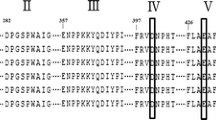Abstract
Thermal sensitive and highly hydrophobic elastin like polypeptide (ELP) tends to undergo inverse transition cycling (ITC) which can be used for non chromatographic purification. The present study reports non-chromatographic purification of industrially important α-amylase tagged with ELP and compared with IMAC (Immobilized metal affinity chromatography) purified α-amylase. amyL-Gene encoding α-amylase from Bacillus licheniformis was cloned and expressed in E. coli BL21. The expressed protein with His-tag was purified through IMAC using Ni–NTA matrix. Three ELP genes encoding repeats of pentapeptide (Val-Pro-Gly-Val-Gly)n with variable length (V = 20, 21, 22) were synthesized through PCR using overlapping primers. To generate ELP tagged α-amylase, amyL was placed at N-terminal of ELPs and transformed to E. coli BL21 for expression. After ITC, ELP22 at 30 °C showed maximum yield. α-Amylase purification through ITC and IMAC showed 2.9 and 1.72-fold purification, respectively. Furthermore, physical parameters of ELP tagged α-amylase have shown improvement with working temperature and thermal stability in comparison to His-tag α-amylase. The k cat /K m for ELP tag and His-tag α-amylase was found to be 61.4 and 23.7 mg−1 min−1, respectively, which shows that ELP-tag increased the enzyme efficiency. In conclusion, the ELP-tag purification strategy can be applied to industrially relevant enzyme for purification by the non-chromatography method.







Similar content being viewed by others
References
Gupta R, Gigras P, Mohapatra H, Goswami VK, Chauhan B (2003) Microbial α-amylases: a biotechnological perspective. Process Biochem 38:1599–1616. doi:10.1016/S0032-9592(03)00053-0
Benjamin S, Smitha RB, Jisha VN, Pradeep S, Sajith S, Sreedevi S, Priji P, Unni KN, Josh S (2013) A monograph on α-amylases from Bacillus spp. Adv Biosci Biotechnol 4:227–241. doi:10.4236/abb.2013.42032
Tomazic SJ, Klibnov AM (1988) Mechanisms of irreversible thermal inactivation of Bacillus α-amylases. J Biol Chem 263:3092–3096
Sassenfeld HM (1990) Engineering proteins for purification. Trends Biotechnol 4:88–93
Nilsson J, Stahl S, Lundeberg J, Uhlén M, Nygren PA (1997) Affinity fusion strategies for detection, purification, and immobilization of recombinant proteins. Protein Expr Purif 11:1–16
Urry DW (1988) Entropic elastic processes in protein mechanisms. I. Elastic structure due to an inverse temperature transition and elasticity due to internal chain dynamics. J Protein Chem 7:1–34
Urry DW (1992) Free energy transduction in polypeptides and proteins based on inverse temperature transitions. Prog Biophys Mol Biol 57:23–57. doi:10.1016/0079-6107(92)90003-O
Urry DW (1997) Physical chemistry of biological free energy transduction as demonstrated by elastic protein-based polymers. J Phys Chem 101:11007–11028. doi:10.1021/jp972167t
Trabbic-Carlson K, Liu L, Kim B, Chilkoti A (2004) Expression and purification of recombinant proteins from Escherichia coli: comparison of elastin-like polypeptide fusion with an oligohistidine fusion. Protein Sci 13:3274–3284. doi:10.1110/ps.04931604
Meyer DE, Chilkoti A (1999) Purification of recombinant proteins fusion with thermally-responsive polypeptides. Nat Biotechnol 17:1112–1115. doi:10.1038/15100
Trabbic-Carlson K, Meyer DE, Liu L, Piervincenzi R, Nath LaBean T, Chilkoti A (2004) Effect of protein fusion on the transition temperature of an environmentally responsive elastin-like polypeptide: A role for surface hydrophobicity? Protein Eng Des Sel 17:57–66. doi:10.1093/protein/gzh006
Kowalczyk T, Hnatuszko-Konka K, Gerszberg A, Kononowicz A (2014) Elastin like polypeptides as a promising family of genetically-engineered protein based polymers. World J Microbiol Biotechnol 30:2141–2152. doi:10.1007/s11274-014-1649-5
Miller GL (1959) Use of dinitrosalicylic acid reagent for determination of reducing sugar. Anal Chem 31:426–429
Bradford MM (1976) A rapid and sensitive method for the quantitation of microgram quantities of protein utilizing the principle of protein-dye binding. Anal Biochem 72:248–254
Sambrook J, Russell DW (2001) Molecular cloning: a laboratory manual, 3rd edn. Cold Spring Harbor Laboratory Press, New York
Christensen T, Amiram M, Dagher S, Trabbic-Carlson K, Shamji MF, Setton LA, Chilkoti A (2009) Fusion order controls expression level and activity of elastin-like polypeptide fusion proteins. Protein Sci 18:1377–1387. doi:10.1002/pro.157
Kim JY, Mulchandani A, Chen W (2005) Temperature-triggered purification of antibodies. Biotechnol Bioeng 90:373–379. doi:10.1002/bit.20451
Jenikova G, Lao UL, Gao D, Mulchandani A, Chen W (2007) Elastin-calmodulin scaffold for protein microarray fabrication. Langmuir 23:2277–2279
Hassouneh W, Christensen T, Chilkoti A (2010) Elastin-like polypeptides as a purification tag for recombinant proteins. Curr Protoc Protein Sci 6:11. doi:10.1002/0471140864.ps0611s61
Urry DW, Luan CH, Parker TM, Gowda DC, Prasad KU, Reid MC, Safavy A (1999) Temperature of polypeptide inverse temperature transition depends on mean residue hydrophobicity. J Am Chem Soc 113:4346–4348. doi:10.1021/ja00011a057
Krishnan T, Chandra AK (1983) Purification and characterization of α-amylase from Bacillus licheniformis CUMC305. Appl Environ Microbiol 46:430–437
Moscaelli P, Boraldi F, Bochicchio B, Pepe A, Salvi AM, Quaglino D (2014) Structural characterization and biological properties of the amyloidogenic elastin-like peptide (VGGVG)3. Matrix Biol 36:15–27
Urry DW, Trapane TL, Prasad KU (1985) Phase-structure transitions of the elastin polypentapeptide-water system within the framework of composition-temperature studies. Biopolymers 24:2345–2356. doi:10.1002/bip.360241212
Shimazu M, Mulchandani A, Chen W (2003) Environmentally triggered purification and immobilization of elastin-OPH fusions. Biotechnol Bioeng 81:74–79. doi:10.1002/bit.10446
Acknowledgements
The authors wish to thank the Department of Biotechnology (DBT) (Project No BT/PR9727/GBD/27/505/2013), New Delhi for financial support.
Author information
Authors and Affiliations
Corresponding author
Ethics declarations
Conflict of interest
The authors do not have any conflict of interest to declare.
Rights and permissions
About this article
Cite this article
Akhani, R.C., Patel, A.T., Patel, M.J. et al. Column Chromatography Free Purification of Recombinant α-Amylase from Bacillus licheniformis by Tagging with Hydrophobic Elastin Like Polypeptide. Proc. Natl. Acad. Sci., India, Sect. B Biol. Sci. 88, 1249–1255 (2018). https://doi.org/10.1007/s40011-017-0862-z
Received:
Revised:
Accepted:
Published:
Issue Date:
DOI: https://doi.org/10.1007/s40011-017-0862-z




